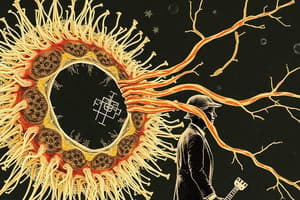Podcast
Questions and Answers
What is the primary effect of hyperpolarization produced by inhibitory signals on excitatory synapses?
What is the primary effect of hyperpolarization produced by inhibitory signals on excitatory synapses?
- It enhances depolarization of excitatory synapses.
- It creates a stronger action potential at the trigger zone.
- It reduces the depolarization of excitatory synapses. (correct)
- It prevents neurotransmitter release at the axonal terminal.
How does the summation of excitatory postsynaptic potentials (EPSPs) and inhibitory postsynaptic potentials (IPSPs) influence action potential generation?
How does the summation of excitatory postsynaptic potentials (EPSPs) and inhibitory postsynaptic potentials (IPSPs) influence action potential generation?
- It determines the overall magnitude of depolarization reaching the trigger zone. (correct)
- It singularly blocks the effects of excitatory synapses.
- It eliminates the need for synaptic integration.
- It always results in a higher frequency of action potentials.
What role does the amplitude of the depolarization play in action potential generation?
What role does the amplitude of the depolarization play in action potential generation?
- Lower amplitude leads to more neurotransmitter release.
- Amplitude has no effect on neurotransmitter release.
- Higher amplitude results in greater action potential frequency. (correct)
- Higher amplitude inhibits action potential generation.
What is the main purpose of neural circuits in the nervous system?
What is the main purpose of neural circuits in the nervous system?
What initiates the depolarization of a neuron leading to an action potential?
What initiates the depolarization of a neuron leading to an action potential?
Which phrase best describes the competitive effects of excitatory and inhibitory synapses?
Which phrase best describes the competitive effects of excitatory and inhibitory synapses?
What characterizes an action potential (AP) compared to excitatory postsynaptic potentials (EPSPs)?
What characterizes an action potential (AP) compared to excitatory postsynaptic potentials (EPSPs)?
How does the electrochemical strength of K+ change during the depolarization phase of an action potential?
How does the electrochemical strength of K+ change during the depolarization phase of an action potential?
What is the role of excitatory postsynaptic potentials (EPSPs) in the generation of an action potential?
What is the role of excitatory postsynaptic potentials (EPSPs) in the generation of an action potential?
Which type of synapse is generally associated with inhibitory functions within the central nervous system?
Which type of synapse is generally associated with inhibitory functions within the central nervous system?
What type of synapse is described as consisting of a presynaptic terminal and a postsynaptic dendritic spine?
What type of synapse is described as consisting of a presynaptic terminal and a postsynaptic dendritic spine?
Which proteins are found in the postsynaptic density of a glutamatergic synapse?
Which proteins are found in the postsynaptic density of a glutamatergic synapse?
What is the role of excitatory amino acid transporters (EAATs) in a glutamatergic synapse?
What is the role of excitatory amino acid transporters (EAATs) in a glutamatergic synapse?
Which receptor types are found on the postsynaptic dendritic spine in a glutamatergic synapse?
Which receptor types are found on the postsynaptic dendritic spine in a glutamatergic synapse?
What is the function of scaffolding proteins in the postsynaptic density?
What is the function of scaffolding proteins in the postsynaptic density?
What role does clathrin play in vesicle formation?
What role does clathrin play in vesicle formation?
What facilitates the detachment of a neovesicle from the membrane?
What facilitates the detachment of a neovesicle from the membrane?
Which neurotransmitter is classified as a classic neurotransmitter?
Which neurotransmitter is classified as a classic neurotransmitter?
During the docking process, how does α-synuclein change?
During the docking process, how does α-synuclein change?
What occurs to the neurotransmitter after it is released?
What occurs to the neurotransmitter after it is released?
What is responsible for synthesizing low molecular weight neurotransmitters?
What is responsible for synthesizing low molecular weight neurotransmitters?
What area are low molecular weight neurotransmitters synthesized and stored in?
What area are low molecular weight neurotransmitters synthesized and stored in?
What method is used to transport neuropeptide precursors?
What method is used to transport neuropeptide precursors?
What is the role of NMDA receptors in synaptic transmission?
What is the role of NMDA receptors in synaptic transmission?
Which components are involved in the presynaptic changes during LTP induction?
Which components are involved in the presynaptic changes during LTP induction?
What effect does high-frequency stimulation (HFS) have on synaptic transmission?
What effect does high-frequency stimulation (HFS) have on synaptic transmission?
Under physiological conditions, what happens to synaptic transmission in the striatum following tetanic activation?
Under physiological conditions, what happens to synaptic transmission in the striatum following tetanic activation?
What does intracellular Ca2+ primarily mediate in LTP?
What does intracellular Ca2+ primarily mediate in LTP?
Which statement about AMPA receptors is correct regarding LTP induction?
Which statement about AMPA receptors is correct regarding LTP induction?
What role does the presence of Mg2+ play in NMDA receptor activation?
What role does the presence of Mg2+ play in NMDA receptor activation?
Which brain structures are involved in memory formation?
Which brain structures are involved in memory formation?
Flashcards are hidden until you start studying
Study Notes
Clathrin and Vesicle Formation
- Clathrin shapes membrane curvature for coated vesicle formation.
- Dynamin is responsible for vesicle detachment, utilizing GTP.
- Neovesicles transport neurotransmitters to reserve pools via transporters.
α-Synuclein Function
- Initially unstructured; undergoes conformational changes upon vesicle binding.
- Transforms into α-helical structures, facilitating SNARE complex assembly during docking and priming.
Neurotransmitter Release and Reuptake
- After release, neurotransmitters may:
- Be reabsorbed by pre-synaptic terminals through transporters like H+-ATPase and H+-NT exchanger.
- Be metabolized or diffuse into extra-synaptic zones.
- Be taken up by glial cells for metabolization.
Categories of Neurotransmitters
- Classic neurotransmitters include:
- Low molecular weight: Acetylcholine, monoamines (dopamine, noradrenaline, histamine, serotonin), and amino acids (GABA, glycine, glutamate).
- Neuropeptides encompass over 50 types, such as opioids, substance P, hormones, and insulin.
Low Molecular Weight Neurotransmitter Synthesis
- Synthesized at synaptic terminals and stored in small vesicles (40-60 nm).
- Slow axonal transport of substances occurs at a rate of 0.5 – 5 mm/day.
Neuropeptide Synthesis
- Precursors are modified by specific enzymes while transported in vesicles along microtubules.
Action Potential (AP) Dynamics
- During depolarization, Na+ influx surpasses K+ efflux, shifting the membrane potential to less negative values.
- AP is a rapid polarity inversion characterized by voltage-gated Na+ and K+ channel activation.
- Threshold for AP determined by synaptic excitatory post-synaptic potentials (EPSPs).
Synaptic Integration
- Neurons integrate multiple excitatory and inhibitory signals to determine responses.
- Morphological synapse types include:
- Type I: Typically excitatory.
- Type II: Typically inhibitory.
Inhibition and Competitive Effects
- Localized inhibitory synapses on the cell body decrease excitatory synapse effects through Cl- channel activation.
- Simultaneous excitatory and inhibitory signals result in EPSP and inhibitory post-synaptic potential (IPSP) summation.
Frequency of Action Potentials
- Amplitude of synaptic current summation dictates the frequency of APs, influencing neurotransmitter release at axonal terminals.
- Increased depolarization correlates with increased AP frequency and information transmission.
Neural Circuits and Brain Networks
- Neural circuits consist of interconnected neurons achieving specific functions.
- Glutamatergic synapses involve presynaptic terminals rich in glutamate transporters and mitochondria.
Postsynaptic Density and Receptors
- Dendritic spines concentrate effector proteins like glutamate receptors and signaling enzymes in lipid rafts and scaffolding proteins.
- Changes in presynaptic glutamate release are modulated by retrograde messengers.
Memory Formation Structures
- Key brain regions for memory include hippocampus, cortex, basal ganglia, cerebellum, and amygdala.
- Long-Term Potentiation (LTP) and Long-Term Depression (LTD) arise from repeated neuronal stimulation.
Role of Receptors in LTP
- AMPA and NMDA receptors are critical in LTP formation, with NMDA receptors acting as coincidence detectors.
- Intracellular Ca2+ is involved in both early and later LTP stages.
Electrophysiology in Brain Slices
- High-frequency stimulation induces changes in synaptic transmission in the striatum.
- NMDAR antagonists prevent LTP and reveal LTD under specific conditions.
- AMPAR antagonists do not inhibit LTP induction, illustrating the distinct roles of receptor types in synaptic plasticity.
Studying That Suits You
Use AI to generate personalized quizzes and flashcards to suit your learning preferences.





